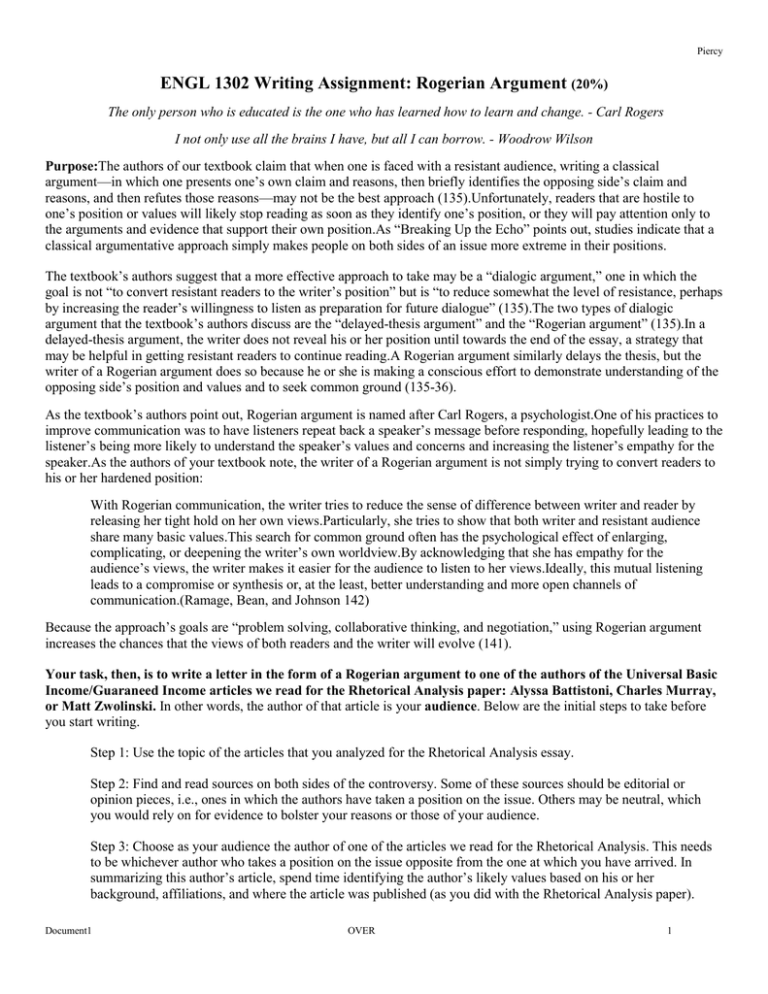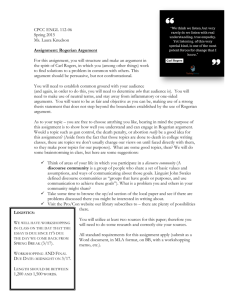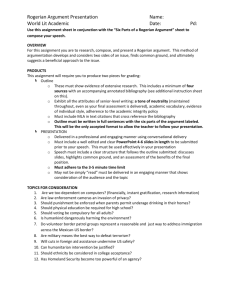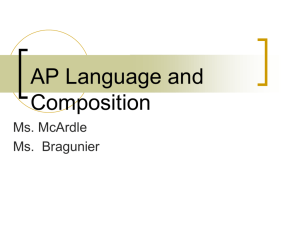ENGL 1302: General Guidelines for the Research Paper
advertisement

Piercy ENGL 1302 Writing Assignment: Rogerian Argument (20%) The only person who is educated is the one who has learned how to learn and change. - Carl Rogers I not only use all the brains I have, but all I can borrow. - Woodrow Wilson Purpose:The authors of our textbook claim that when one is faced with a resistant audience, writing a classical argument—in which one presents one’s own claim and reasons, then briefly identifies the opposing side’s claim and reasons, and then refutes those reasons—may not be the best approach (135).Unfortunately, readers that are hostile to one’s position or values will likely stop reading as soon as they identify one’s position, or they will pay attention only to the arguments and evidence that support their own position.As “Breaking Up the Echo” points out, studies indicate that a classical argumentative approach simply makes people on both sides of an issue more extreme in their positions. The textbook’s authors suggest that a more effective approach to take may be a “dialogic argument,” one in which the goal is not “to convert resistant readers to the writer’s position” but is “to reduce somewhat the level of resistance, perhaps by increasing the reader’s willingness to listen as preparation for future dialogue” (135).The two types of dialogic argument that the textbook’s authors discuss are the “delayed-thesis argument” and the “Rogerian argument” (135).In a delayed-thesis argument, the writer does not reveal his or her position until towards the end of the essay, a strategy that may be helpful in getting resistant readers to continue reading.A Rogerian argument similarly delays the thesis, but the writer of a Rogerian argument does so because he or she is making a conscious effort to demonstrate understanding of the opposing side’s position and values and to seek common ground (135-36). As the textbook’s authors point out, Rogerian argument is named after Carl Rogers, a psychologist.One of his practices to improve communication was to have listeners repeat back a speaker’s message before responding, hopefully leading to the listener’s being more likely to understand the speaker’s values and concerns and increasing the listener’s empathy for the speaker.As the authors of your textbook note, the writer of a Rogerian argument is not simply trying to convert readers to his or her hardened position: With Rogerian communication, the writer tries to reduce the sense of difference between writer and reader by releasing her tight hold on her own views.Particularly, she tries to show that both writer and resistant audience share many basic values.This search for common ground often has the psychological effect of enlarging, complicating, or deepening the writer’s own worldview.By acknowledging that she has empathy for the audience’s views, the writer makes it easier for the audience to listen to her views.Ideally, this mutual listening leads to a compromise or synthesis or, at the least, better understanding and more open channels of communication.(Ramage, Bean, and Johnson 142) Because the approach’s goals are “problem solving, collaborative thinking, and negotiation,” using Rogerian argument increases the chances that the views of both readers and the writer will evolve (141). Your task, then, is to write a letter in the form of a Rogerian argument to one of the authors of the Universal Basic Income/Guaraneed Income articles we read for the Rhetorical Analysis paper: Alyssa Battistoni, Charles Murray, or Matt Zwolinski. In other words, the author of that article is your audience. Below are the initial steps to take before you start writing. Step 1: Use the topic of the articles that you analyzed for the Rhetorical Analysis essay. Step 2: Find and read sources on both sides of the controversy. Some of these sources should be editorial or opinion pieces, i.e., ones in which the authors have taken a position on the issue. Others may be neutral, which you would rely on for evidence to bolster your reasons or those of your audience. Step 3: Choose as your audience the author of one of the articles we read for the Rhetorical Analysis. This needs to be whichever author who takes a position on the issue opposite from the one at which you have arrived. In summarizing this author’s article, spend time identifying the author’s likely values based on his or her background, affiliations, and where the article was published (as you did with the Rhetorical Analysis paper). Document1 OVER 1 Piercy Step 4:Reread pages 145-47 and 152-53 in our textbook, which contain examples of Rogerian argumentative essays.As the student writer of the first essay does, you should support both your audience’s reasons and your own with evidence from other sources. Step 5:See page 144 for a way of organizing a Rogerian argument. Guidelines: 1. Length:The essay must be a minimum of 1100 words (excluding Works Cited page). That should be over four pages, minimum. 2. Number and types of sources: a. The essay must actually use (not just list) a minimum of three sources (excluding whichever of our Rhetorical Analysis essays authos you choose as your principal audience.). b. At least two of your sources must be library sources (i.e.library books or articles or books from the library’s electronic databases).Databases we have LSC college access to include Opposing Viewpoints, CQResearcher, and Issues & Controversies (all accessible from the “Current Issues” category under the “Research Databases” link on the library’s web site). c. While you may search the “free” Internet for sources, those sources must be in addition to the required number of library sources and must be appropriate for academic research; for example, they may not be other students’ essays or from sites that offer papers for sale or provide editing services.You are ultimately responsible for evaluating the reliability of such sources. 3. Organization:Beware of creating body paragraphs that are too long or too short.A body paragraph should contain sufficient details so that its topic is clear and convincing, but it should not be so long that the reader cannot remember and relate together the entire paragraph’s supporting details.In other words, this essay must have more than the five paragraphs. 4. Quoting and paraphrasing:The essay must not only actually use all of the secondary sources, but it also must include at least several examples of both quoted and paraphrased ideas or information—both of which must be documented using MLA or APA style. 5. Diction:since you are writing a letter, it is acceptable to use first-person pronouns (e.g.“I,” “me,” “my,” “we”) and second-person pronouns (e.g.“you”). 6. Formatting:The paper should be formatted as your previous essays were:it must be typed and double-spaced, use 12 point font, and have 1” margins, and the first line of each paragraph should be indented one-half inch. 7. Evaluation:The essay should demonstrate a genuine attempt to understand the opposing side’s reasons and values and to explore common ground, and it should contain substantial information from the sources supporting both sides’ reasons. Rogerian essays prize and practice not only empathy, but imaginative solutions: What possible concessions and common ground can there be in this rhetorical situation? 8. Deadline:Essays are due at the beginning of class on the day listed in the schedule.Essays that are not printed out and complete at that point will be assessed a late penalty.(I deduct 10 points until the next class and 10 points for each class after that.I do not accept essays emailed to me or placed in my mailbox because inevitably some of the essays from students who claim that they emailed them or placed them in my mailbox do not make it to me. There will also be a Dropbox in D2L for this paper. Your electronic document should be uploaded by the end of the due date day. 9. Note:This is not a group or collaborative project. No student’s essay or Works Cited page should closely resemble any other person’s. Document1 OVER 2


